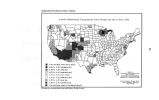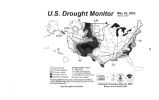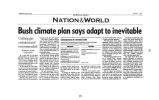| OCR Text |
Show 30 and below normal. And even at that, I don't know the exact number, but I would suspect it's somewhere between 50 and 60 percent accurate and that's not good enough but that's just my opinion. Dr. POTTER. I confirm that. The temperature predictions are somewhere around close to 60 percent, the precipitation is a little lower. If you talk to some of the long range forecasters, climate forecasters at the Climate Prediction Center, they will say that it's just barely over 50 percent. It isn't a lot but it is improved somewhat. There are certain other periods, such as when an El Nino sets in or a La Nina sets in, and the signals are much better, stronger than they are across the board. So in those periods they may be rising into the level of 60 or 65 percent and maybe even higher. But that doesn't happen all the time. And I agree with Mark, it's not good enough. It is a little better than it was 20 years ago, when we had no knowledge of the El Nino, La Nina and the rest. There are some figures available, I don't have them on the tip of my tongue or right here, but I can get them, about the statistical representation that you talked about. Mr. EUBANK. Let me add just one more comment. When an El Nino comes along, Southern California and Arizona and Southern Utah respond wet in the wintertime. That's recognized. Salt Lake City, during an El Nino year, half of those times it's really wet and half of those times it's really dry. So El Nino doesn't mean hardly anything for Salt Lake City. And that's what happens around the country. Some areas it responds and other areas it doesn't. Mr. BAIRD. HOW in your experience, and this may be beyond your area of specialization and maybe others will comment on it, I want to follow on the theme I have just introduced, the predictability and accuracy of that. I am looking at this chart here and we have got a broad spectrum, some days, some years it's pretty wet and some years it's pretty dry. How does our urban planning or our agricultural planning take into account the frequency of drought? Do we tend to overly- and, again, this may not be your area, but are we overly optimistic? Do we plan for the wet years and hope we don't have dry years? Or how does that take into account just in urban planning or agricultural planning? Mr. EUBANK. Well, in Utah, knowing that those deviations swing so big, most reservoirs for local consumption are designed to run at two- year capacity. And a two- year capacity doesn't mean it just has two years, it means that that cushion let's you get- well, we are already four years in, and we are skimping and we're being very careful and conserving but we are still getting by. So that mind set and that experience allows you to design water works to handle these situations and I think the water planners have done a marvelous job of that. Mr. BAIRD. SO they are taking that into account? Mr. EUBANK. They are. Mr. BAIRD. Thank you, Mr. Chairman. HALE CYCLE Mr. CANNON. Mr. Eubank, you talked about the HALE cycles, this 22 years which is predictable for America. I'm just wondering, looking at your chart we have given here, it looks like we had a |


























































































